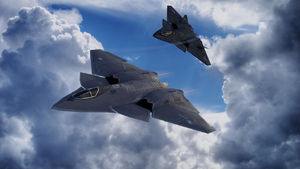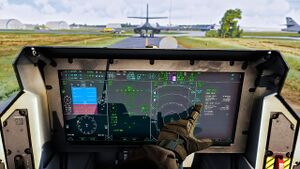Gruening F7M Wedgetail: Difference between revisions
No edit summary |
|||
| Line 6: | Line 6: | ||
|type = {{wpl|Stealth aircraft}}<br>{{wpl|Multirole combat aircaft|Multirole fighter}} | |type = {{wpl|Stealth aircraft}}<br>{{wpl|Multirole combat aircaft|Multirole fighter}} | ||
|national origin = {{flag|Meridon}} | |national origin = {{flag|Meridon}} | ||
|manufacturer = Gruening Defense Aerospace | |manufacturer = [[Gruening Defense Aerospace]] | ||
|design group = | |design group = | ||
|designer = | |designer = | ||
Revision as of 10:21, 3 May 2024
| Gruening F7M Wedgetail | |
|---|---|

| |
| A pair of F7Ms of the Meridonian Air Forces, showcasing the distinctive foldable twin-tails. | |
| Role | Stealth aircraft Multirole fighter |
| National origin | |
| Manufacturer | Gruening Defense Aerospace |
| First flight | 14 August 2014 |
| Introduction | 30 March 2020 |
| Status | In active service |
| Primary user | |
| Produced | 2016-present |
| Number built | 324 |
| Unit cost |
95.1 million MD (F7M A)
|
The Gruening F7M Wedgetail is a Meridonian carrier-capable, supersonic, twin engine, single seat, twin tail, stealth jet fighter. Envisioned to supplement and replace older models of aircraft in service with the Meridon Defense Forces and increase commonality, the project is unique in that it is the first joint venture of a fighter aircraft from the initiation of the project to include both Air Forces and Navy design inputs since the 1960s- prior, Air Force fighter designs had fallen through, resulting to the utilization of Navy designs, as was the case for the F5M Lynx and the F6M Wasp programs.
The Wedgetail was designed from its inception to be a multi-role oriented stealth fighter capable of most combat mission sets required of fighter aircraft, including air superiority, ground attack, close air support, electronics warfare, maritime strike, reconnaissance, interdiction, and the employment of standoff weaponry. The Wedgetail is also unique in that it is one of the few aircraft globally that features compatibility for both 'probe and drogue' and boom- method refueling, owing to differing operational requirements from the Air Forces and Navy.
Marketed as a 5.5 generation fighter, the aircraft's software and airframe are designed with modular architecture to be capable of future upgrades, as this aircraft is planned to serve for the majority of the 21st century and will serve alongside the Gruening F9M Osprey, a variant developed from the Wedgetail's own parts and design.
The Wedgetail is currently being introduced to flying squadrons in the Air Forces and Navy where it is replacing F5M airframes.
Development
Design

Operational History
Variants
- F7M
- Initial operational variant, first fielded 2023. Air Force variants are designated F7M A and feature a weaker tailhook and lighter wheel mechanism and lack folding wings; naval variants are designated F7M C and feature reinforced landing and arresting gear and feature folding wingtips.
- A9M2 Strike Wedgetail
A lengthened modification of the F7M-A featuring a two-man cockpit, conformal fuel tanks, lengthened wings, and enlarged internal weapons bays and fuselage. It is intended to replace the A8M Gharial in interdiction roles.
Operators
Current Operators
Former Operators
Specifications (F7M)
General Characteristics
- Crew: 1
- Length: 61 ft 4 in (18.7m)
- Wingspan: 39 ft 4 in (12 m)
- Height: 16 ft (4.9 m)
- Wing Area: 790 sq ft (735 m2)
- Empty Weight: 45,624 lb (20,694 kg)
- Max Takeoff Weight: 76,820 lb (34,844 kg)
- Powerplant: 2 × Hollon AFT11 afterburning turbofans producing 28,500lbf (military power) or 43,500lbf (afterburner) each
- Fuel Capacity: 19,600lb internal, 2x optional 267gal (1,756lb/797kg) external tanks
Performance
- Maximum Speed: Mach 2.52 (3,112 km/h, 1,934 mph) at altitude
- Service Ceiling: 60,000 ft (18,288 m) +
- Rate of Climb: 52,000 ft/min plus (264 m/s)
- Wing Loading: 74 lb/sq ft (361 kg/m2)
- Thrust/Weight: 1.13 at maximum takeoff weight
Armament
- Guns: 1 × Type 40 25mm cannon with 450 rounds
- Payload: 10x internal hardpoints, with option for 4x wing-mounted hardpoints, capacity of 25,000lb (11,339kg)
- 6x centerline hardpoints
- 2x fuselage hardpoints for SRAAM/equivalent
- 2x wing hardpoints for CAIMS/ERIS/equivalent
- 4x optional (2x per wing) hardpoints
Avionics
- TA-46D active electronically scanned array radar
- AE-161D radar warning reciever
- AO-62 electro-optical distributed aperture system (EO-DAS)
- AE-202 Electronic Warfare/ Defensive Electronic Countermeasures System
- AO-104 electro-optical multifunction targeting system
